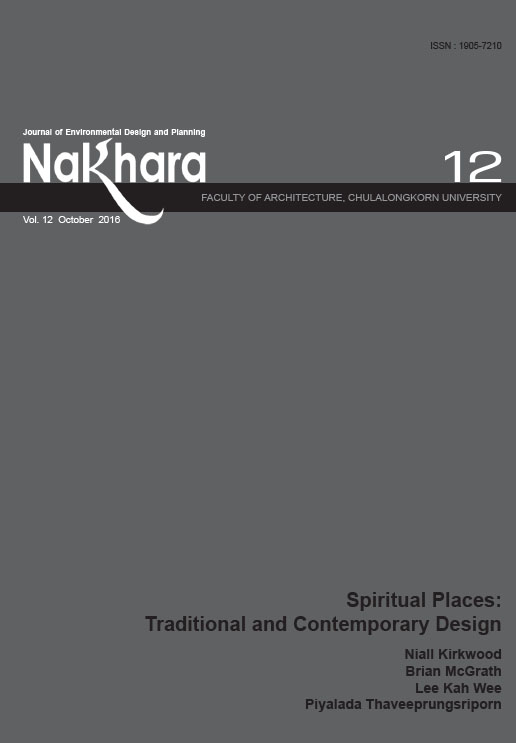Sustaining Urban Spatial Network of Historical Communities Through the Reuse of Temple Grounds and Social Space – A Case Study of Rattanakosin, Bangkok
Main Article Content
Abstract
Old communities in Rattanakosin, a historical center of Bangkok, have been the model of a vibrant mixuse urban area where residences, temples, schools and local retailers are clustered in close proximity.
The Rattanakosin area has distinctive spatial characteristics hardly found in other areas of Bangkok; small
urban blocks, a dense grid network for pedestrian only, and a large number of Buddhist temples well integrated within communities. The mapping of space usage reveals how local inhabitants, as well as tourists, interact within a series of public open spaces. How this interaction differs at various times and activities are in fact spatially related. This paper aims to clarify how historical communities in Bangkok can sustain their viability
through socio-spatial dialectic patterns by using the analysis of a spatial configuration network in relation to
space use patterns. It also reveals that Buddhist temple grounds, once important public spaces transitioning
between sacred temple areas and profane urban surroundings, no longer act as important social spaces in
local communities. The analytical results suggest that sustaining the urban vitality of historical communities
in the Rattanakosin could be done by reintegrating the existing small public open spaces in the area. This
approach addresses the temple grounds within the internal pedestrian grid network as well as the external
road network. The interconnecting and well hierarchical urban spatial network will create a good mix of
local inhabitants and tourists in the area.
Article Details
References
Benedikt, M.L. (1979). To take hold of space: lsovists and isovists fields. Environment and Planning B., 6, 47-65.
Giddens, A. (1984). The constitution of society: Outline of the theory of structuration. Cambridge: Polity press.
Hillier, B., & Hanson, J. (1984). The social logic of space. Cambridge: Cambridge University press.
Hillier, B. (1989, january-february, march-april). The architecture of the urban object. Ekistics. 334-335, 5-20.
Hillier, B. (1996). Space is the machine. Cambridge, MA.: Cambridge University press.
Jacobs, J. (1961). The death and life of great American cities. London: Penguin books.
Knox, P., & Pinch, S. (2000). Urban social geography: an introduction (fourth edition). Boston, MA.: pearson.
Massey, D. et al., (Eds.). (1999). City worlds. London: Routledge.
Paksukcharern, K. (2008). Isovists and public space use patterns (in Thai)(master thesis). Synthesis for the 2007 graduate research fund, Bangkok.
Promprawat, P. (2008). Isovist and public space use patterns; a case study of Sao Ching Cha community, Bangkok (in Thai)(master thesis). Urban and regional planning, Chulalongkorn University, Bangkok.
Tansukanun, P. (2003). The connections beyond sacred architecture: an analysis through spatial structures and daily rhythms of the temple grounds in a regional city and a small town in the north of Thailand (in Thai). The 2003 Sarasart conference proceedings, Faculty of Architecture, Chulalongkorn University, Bangkok.
Tansukanun, P. (2006). Place and hyper-place in Chiang Mai: Meanings of sacred architecture in the secular age. in traditional, Dwellings and Settlements Review, Journal of the international association for the study of traditional environments, XVIII (I). The tenth international conference, december 15-18, 2006, Bangkok, Thailand.
Turner, V. (1969). The ritual process: Structure and anti-structure. New York: Aldine de Gruyter.
Turner, A., & Penn, A. (1999). Making isovists syntactic: isovist integration analysis. paper presented at the 2nd international symposium on space syntax, Brasilia.
Van Gennep, A. (1908). The rites of passage (translated Vizedom, Monika B. & Caffee, Gabrielle L., Trans.). Chicago: The University of Chicago.

